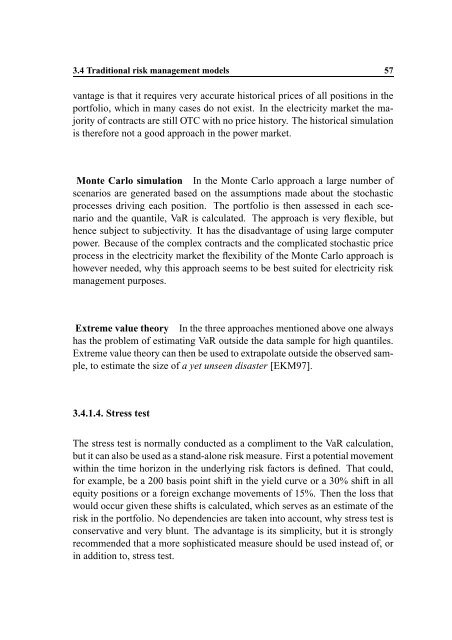Hedging Strategy and Electricity Contract Engineering - IFOR
Hedging Strategy and Electricity Contract Engineering - IFOR
Hedging Strategy and Electricity Contract Engineering - IFOR
You also want an ePaper? Increase the reach of your titles
YUMPU automatically turns print PDFs into web optimized ePapers that Google loves.
3.4 Traditional risk management models 57<br />
vantage is that it requires very accurate historical prices of all positions in the<br />
portfolio, which in many cases do not exist. In the electricity market the majority<br />
of contracts are still OTC with no price history. The historical simulation<br />
is therefore not a good approach in the power market.<br />
Monte Carlo simulation In the Monte Carlo approach a large number of<br />
scenarios are generated based on the assumptions made about the stochastic<br />
processes driving each position. The portfolio is then assessed in each scenario<br />
<strong>and</strong> the quantile, VaR is calculated. The approach is very flexible, but<br />
hence subject to subjectivity. It has the disadvantage of using large computer<br />
power. Because of the complex contracts <strong>and</strong> the complicated stochastic price<br />
process in the electricity market the flexibility of the Monte Carlo approach is<br />
however needed, why this approach seems to be best suited for electricity risk<br />
management purposes.<br />
Extreme value theory In the three approaches mentioned above one always<br />
has the problem of estimating VaR outside the data sample for high quantiles.<br />
Extreme value theory can then be used to extrapolate outside the observed sample,<br />
to estimate the size of a yet unseen disaster [EKM97].<br />
3.4.1.4. Stress test<br />
The stress test is normally conducted as a compliment to the VaR calculation,<br />
but it can also be used as a st<strong>and</strong>-alone risk measure. First a potential movement<br />
within the time horizon in the underlying risk factors is defined. That could,<br />
for example, be a 200 basis point shift in the yield curve or a 30% shift in all<br />
equity positions or a foreign exchange movements of 15%. Then the loss that<br />
would occur given these shifts is calculated, which serves as an estimate of the<br />
risk in the portfolio. No dependencies are taken into account, why stress test is<br />
conservative <strong>and</strong> very blunt. The advantage is its simplicity, but it is strongly<br />
recommended that a more sophisticated measure should be used instead of, or<br />
in addition to, stress test.
















